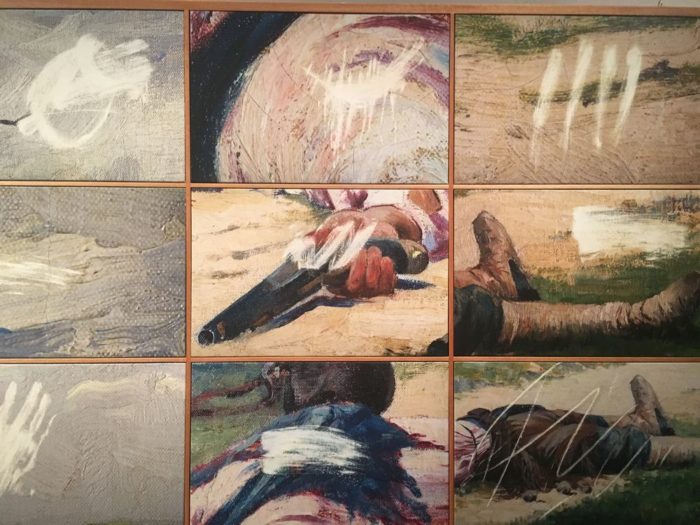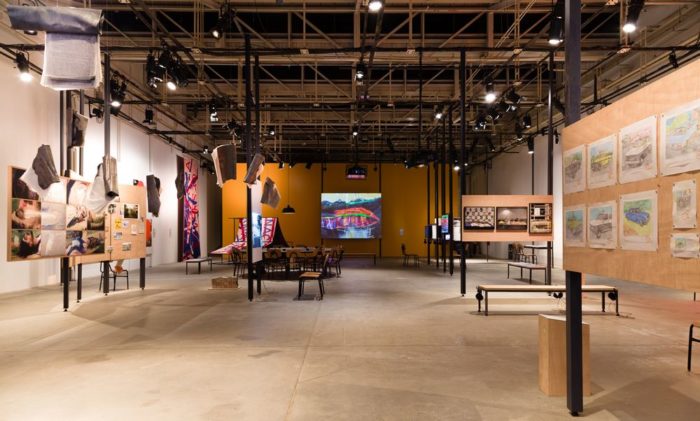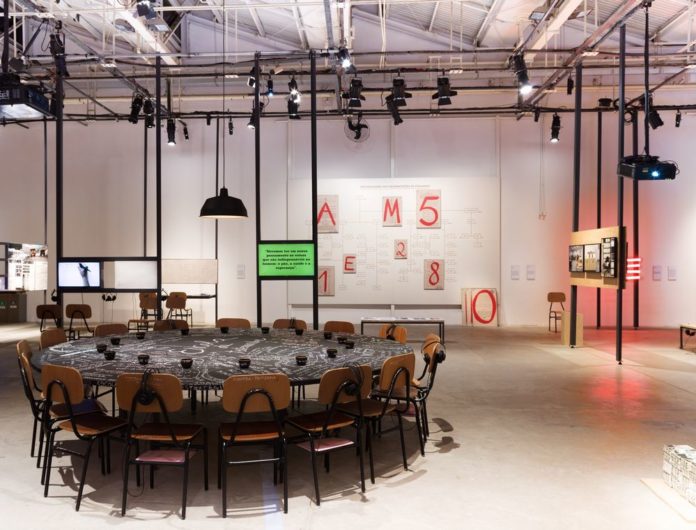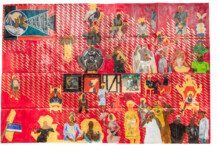“Files alone have no memory. It is with them that you build memory”, says researcher and curator Ana Pato. And in this process of reading, interpretation and meaning of documents and records – traditionally associated with the academic practice of historians and other researchers – artists play a fundamental role, argues Pato, curator of the exhibition Meta–Arquivo: 1964–1985 – Listening and Reading Space of Dictatorship Histories.
Based on this finding, the exhibition at Sesc Belenzinho, created in partnership with the Memorial da Resistência, brings together unpublished works by nine artists, conceived from research in different public and private archives on the Brazilian dictatorship. “Because putting documentation in motion always goes through a mediation process”, says the curator. The mediators in this case are the artists and collectives Ana Vaz, Contrafilé Group, The Whole Group, Giselle Beiguelman, Icarus Lira, Mabe Bethônico, Paulo Nazareth, Rafael Pagatini and Traplev.
The works, in various media and languages, set in motion information and materials that have opened the violence perpetrated by the military regime over 21 years in different areas of national life. The artistic practice emerges – with its peculiarities – as a historian practice, from a desire to make public little known stories and often to question the official historiography. For, as Giselle Beiguelman points out in a work exposed in the show, memory is always a construction. “What did you forget to forget? What did you forget to remember? What did you remember to forget? What did you remember to remember?”, question the phrases written in neons.

A própria artista, na instalação Gaveta de Ossos, “lembra de lembrar”, através de fotos e áudio, do trabalho de reconhecimento feito com as ossadas na Vala de Perus, onde foram enterrados clandestinamente diversas pessoas assassinadas pela ditadura. Paulo Nazareth, em Inquérito, discute a criminalização dos negros a partir da leitura de inquéritos policiais encontrados pelo artista e transformados em áudios – em trabalho feito em colaboração com Michelle Matiuzzi e Ricardo Aleixo.
Em Escola de Testemunhos, o Grupo Contrafilé reproduz em fones de ouvido – situados em uma “mesa-lousa” rodeada de cadeiras escolares – relatos de ex-presos políticos e seus familiares pertencentes ao arquivo do programa Coleta Regular de Testemunhos do Memorial da Resistência. O trabalho, assim como o de Nazareth, explicita um desejo da exposição de expandir o conhecimento sobre quem foram os personagens atuantes na luta contra a ditadura, como explica Pato: “Quisemos descolar um pouco desse imaginário de que a resistência à ditadura foi feita basicamente por homens, brancos, jovens, de classe média e estudantes da USP que entraram na guerrilha. O trabalho do Contrafilé traz uma visão mais ampla, que inclui o movimento operário, movimento de mulheres e mães da periferia, por exemplo”.
A expansão também da noção geográfica sobre a resistência à ditadura – para além do Sudeste ou de casos famosos como a Guerrilha do Araguaia – se dá no trabalho de Ícaro Lira sobre o Crítica Radical, movimento formado nos anos 1970 em Fortaleza. Atuante ainda hoje, o grupo teve uma trajetória multifacetada, com papel fundamental na luta feminista e passagens pela política institucional, pela guerrilha e, posteriormente, assumindo uma luta contra o voto e o capitalismo.

Em outra história pouco conhecida, Rafael Pagatini segue sua pesquisa sobre o papel das instituições culturais durante o regime militar, mostrando meandros das relações entre o governo e três instituições paulistanas: Sesc, MASP e Pinacoteca. Imagens de ditadores em aberturas de exposições impressas em tecidos, por exemplo, revelam como essas instituições ajudavam a dar certo ar de normalidade para o regime – “era como um escudo”, diz o artista –, já que mostras continuavam acontecendo e a arte seguia tendo seu espaço institucional, com aval do governo.
Desenvolvido por Traplev a partir de extensa pesquisa em arquivos – entre eles os que resultaram no livro Brasil: Nunca Mais, realizado clandestinamente por setores da sociedade civil durante os anos finais da ditadura (1979-1985) e que revelou uma série de crimes cometidos pelo regime – a instalação Arma da Crítica/ Orientação para a Prática apresenta dois grandes organogramas, um das organizações de esquerda e outro dos órgãos da repressão, situados em lados opostos da sala expositiva. O artista apresenta ainda um trabalho sobre o educador Anísio Teixeira, morto em 1971 após ser preso por agentes da ditadura.
Em duas grandes instalações feitas em tricô, Texto-Tecido-Teia, O Grupo Inteiro se utiliza de palavras encontrados nas apostilas de formação dos agentes do Serviço Nacional de Informações (SNI). Os manuais, que serviam para orientar a repressão às organizações de esquerda, incluíam dicionários de gírias e expressões que poderiam ser necessárias nas sessões de interrogação e tortura. Logo ao lado, um vídeo da artista Ana Vaz , intitulado Apiyemiyekî? [Por quê?], aborda o genocídio do povo Waimiri-Atroari durante a marcha para o centro-oeste na década de 1970, quando terras indígenas foram invadidas para a construção da BR-174 e para a instalação de uma mineradora. Ilustrações criadas pelos indígenas sobre o período revelam a história traumática vivida pela população, remetendo-nos aos dias atuais.

The artist herself, at the Gaveta de Ossos installation, “remembers remembering”, through photos and audio, of the reconnaissance work done with the bones in the Perus Ditch, where several people murdered by the dictatorship were clandestinely buried. Paulo Nazareth, in Inquérito, discusses the criminalization of black people by reading police inquiries found by the artist and turned into audios – in work done in collaboration with Michelle Matiuzzi and Ricardo Aleixo.
In Escola de Testemunhos, the Contrafilé Group reproduces on headphones – set on a “blackboard table” surrounded by school chairs – reports from former political prisoners and their families belonging to the Archives of the Memorial da Resistência Regular Witness Collection program. The work, like that of Nazareth, expresses a desire of the exhibition to expand the knowledge about who were the acting characters in the fight against the dictatorship, as Pato explains: “We wanted to take off some of this imagination that the resistance to the dictatorship was basically made. by white, young, middle–class men and USP students who joined the guerrillas. Contrafilé’s work brings a broader view, which includes the workers’ movement, the movement of women and mothers from the periphery, for example”.
The expansion of the geographical notion about resistance to dictatorship – beyond the Southeast or of famous cases such as the Araguaia Guerrilla – also occurs in the work of Ícaro Lira on Crítica Radical, a movement formed in the 1970s in Fortaleza. Active even today, the group had a multifaceted trajectory, with a fundamental role in the feminist struggle and passage through institutional politics, the guerrilla and, subsequently, taking on a struggle against the vote and capitalism.
In another little–known story, Rafael Pagatini follows his research on the role of cultural institutions during the military regime, showing the intricacies of relations between the government and three São Paulo institutions: Sesc, MASP and Pinacoteca. Images of dictators at fabric exhibition openings, for example, reveal how these institutions helped to give the regime a certain air of normality – “it was like a shield”, says the artist – as exhibits kept happening and art went on. having its institutional space, with the approval of the government.
Developed by Traplev from extensive archival research – including those resulting in the book Brasil: Nunca Mais, clandestinely conducted by sectors of civil society during the final years of the dictatorship (1979–1985) and which revealed a number of crimes committed by the regime – Arma da Crítica/ Orientação para a Prática installation features two large organizational charts, one of the left–wing organizations and the other of the repressive organs, located on opposite sides of the lecture hall. The artist also presents a work about the educator Anísio Teixeira, who died in 1971 after being arrested by agents of the dictatorship.
In two large knitting installations, Texto–Tecido–Teia, O Grupo Inteiro uses words found in the training handouts of National Information Service (SNI) agents. The manuals, which served to guide repression of leftist organizations, included slang dictionaries and expressions that might be needed in interrogation and torture sessions. Right next door is a video by artist Ana Vaz entitled Apiyemiyekî? [Por quê?] addresses the genocide of the Waimiri–Atroari people during their march to the Midwest in the 1970s, when indigenous lands were invaded for the construction of BR–174 and the installation of a mining company. Illustrations created by the indigenous about the period reveal the traumatic history lived by the population, referring us to the present day.
Finally, Mabe Bethonica researches the relationship of mining companies with the military dictatorship from a doctoral project he discovered on the subject. The artist invited the author of the research, Ana Carolina Reginatto, to teach her on the subject and recorded the process in videos. The final work, entitled Elite Mineral [Gabinete de Aprendizado] is another that, according to the curator, brings us directly to recent events in the country. “With Mabe’s work, it is clear what is happening in Brumadinho. When you look at Ana Vaz’s work, you better understand what is happening on the indigenous issue. So we are making calls that we don’t seem to make in Brazil”, says Pato.
Revisionism and learning
If the work group created by Ana Pato with the artists to research the memory of dictatorship emerged in 2018, it was from the beginning of this year, after the inauguration of Jair Bolsonaro, that the process of production of the works intensified. The theme went further into the agenda in a context in which the President of the Republic defends the military regime, praises torturers and encourages the commemoration of the date of the 1964 coup. “We are living a moment of revisionism of our official history. Because the military dictatorship is in our official history, it did not seem to be a narrative we had exactly to prove. But things have changed”, says the curator.
“The impression I have is that we are kind of disconnected from who we are, from our nation building. So to understand what we are living, nothing better than looking back, learning from history to be more aware of the present”, she says, reinforcing Meta–Arquivo’s pedagogical role – especially in times of denial of historical facts. and dissemination of false information. No wonder, explains Pato, the show has the subtitle Listening Space and Reading of Dictatorship Histories. “I think the exhibition is a place of learning. It seems to me that if we need to get back to reality, somehow the artist can be this way of the symbolic so that we look back at the real. ”

By making undisclosed stories public, there is also the possibility of some reparation or at least dealing with past wounds. “In Brazil, we did not recognize our debts, our traumatic history. And the genocides of the black, indigenous population, that remains. It’s the very concept of trauma, the past that doesn’t want to go through, what is always coming back”, says Pato. In this sense, the curator refers to a story that begins long before the military dictatorship, with deep roots that come from the arrival of the colonizers and the period of slavery. For her, it is only from this historical complexity that one can understand the current “dualism and split of Brazilian society”.
In a large shed of Sesc Belenzinho, the show presents itself as a space for dialogue between the works, mounted between apparent metal structures and small wooden surfaces, allowing the overlapping of the stories presented. About Anna Ferrari’s expographic project, the curator explains: “It also has to do with the idea of archiving, to pervert the very idea of boxes. I wish I could see any work from any angle. But the point is this: you will never have the perfect angle, you will always have the other side”.








